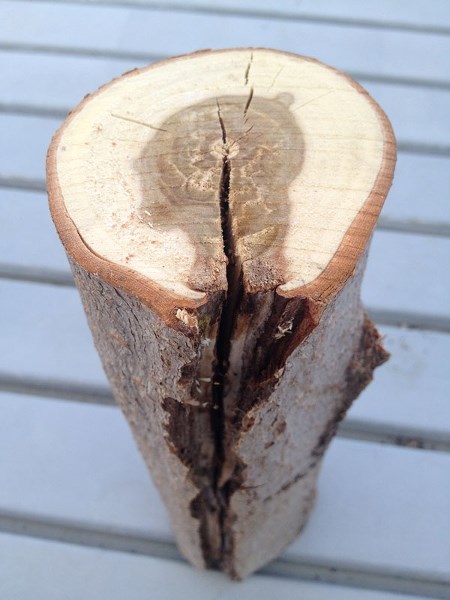There’s much more to tree pruning than slathering black goop on to a freshly cut branch.
Jim Hole, owner of Hole’s Greenhouses, drew 400 people to a seminar recently, suggesting to him that folks are eager to prune and want to know how to do it properly and save some money at the same time.
Pruning a tree serves two purposes, Hole says: aesthetics and safety. Proper pruning will make your trees look good and can enhance the value of your property, but there’s a more practical reason for pruning away branches that are dead, dying or diseased. Weak branches are more likely to break off in a wind or ice storm, and a branch that’s broken off obviously poses a danger, but it also exposes the tree to potentially fatal consequences.
“Trees don’t heal. Trees wall off.
“If they sustain an injury from a pruning cut, they react by entombing that damaged tissue for the life of the tree.”
If a branch breaks off, however, the tree has a hard time creating that protective wall. Such an opening to the core of the tree can lead to its death.
The first thing Hole advises is to learn how to prune properly. The second is to prune regularly.
“What I find far too often is that people are so fearful of pruning that they let the trees grow with fairly weak branches on the trunk of the trees, and then down the road, they split off. And then they say, ‘Now, what do I do?’ Well, the car has crashed.”
Proper pruning requires an understanding of what helps and hurts a tree. Knowing when to prune and when not to is crucial.
Generally, spring is the best time to prune because the growth season is at hand, and the tree won’t be affected by surprise weather conditions. Hole says pruning in October in our region isn’t usually a problem because trees are going dormant as the days grow shorter and the nights cooler. Trees won’t be tricked into producing shoots that will be killed when cold weather arrives.
“The biggest issue with pruning in the fall is that if you prune a little bit too early, there is a chance of stimulating some late-season growth,” Hole says.
“Anytime you prune a branch or the leader of the tree, it creates a situation where the hormonal level changes, the plant responds by sending out a bunch of shoots that are not winter hardy, and they die off.”
Knowing where to cut is also crucial. Open cuts do not heal on a tree, but a proper cut won’t hurt the tree. Cutting too close to the trunk, though, can be disastrous, he says.
“A common issue with pruning is not pruning correctly. People leave stumps on the tree, and the problem with a stump is that a stump is like a landing pad, a source for fungal diseases to attack the tree. It’s a great base. They can feed on the dead tissue.
“Even though the tree has got some nice protection inside of it to wall off damage from different diseases, it’s getting attacked at a high level.”
The “sacred zone” is near the trunk. Cutting too close to the trunk opens the tree up to bugs and diseases it can’t protect itself from. Never cut flush to the trunk, Hole warns.
Most cuts, done properly, don’t require pruning paint, but the paint may inhibit insect attacks. An open cut emits chemicals that attract insects, so painting over the cut will mask those chemicals.
Having the right tools is equally important. Every pruner should have a proper pruning saw, which is curved and has teeth. The other tools include a hand pruner, which comes in left and right-handed versions; a lopper to cut bigger branches; and a pole pruner to reach really high in the tree.
People can do a lot of their own pruning if they know what they’re doing, but in some instances, hiring a professional is wise. Climbing ladders to reach high branches can be hazardous, and using a pole pruner calls for good balance and some strength.
There’s much more to know about pruning different kinds of trees and shrubs. Jim Hole will do another pruning presentation at Holes’ Greenhouses on Oct. 15. The presentation is free, but you’ll have to register either online at http://www.holesonline.com/ or by phone.




